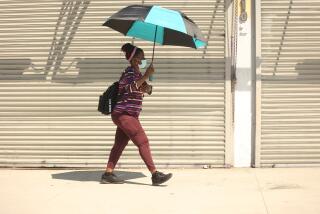Play hard, but don’t get beat by the heat
- Share via
My favorite activities are all outdoors: running, basketball, hiking and beach volleyball. Is it safe to do these activities in the summer when it is so hot? I notice a big difference in my energy level when I work out in the heat -- but is it dangerous for my body?
Pat
Ventura
--
Whether you exercise indoors or outdoors, high temperatures can cause heat injury. Here are some tips to minimize your risk and maximize your results:
Hydration: It is especially important to drink lots of fluids during exercise in higher temperatures. A good rule of thumb is to consume 6 to 8 ounces of fluid before exercise, about 4 to 6 ounces of fluid every 20 minutes during exercise and at least 6 to 8 ounces immediately after exercise. Don’t use thirst as an indicator of when you should drink water. By the time you’re thirsty, you’re probably already a bit dehydrated.
Water is the best fluid if your exercise session lasts less than an hour. Sports drinks are an option (if they’re comfortable on your stomach) when your session lasts more than an hour.
Intensity: Plan to reduce your level of intensity when you exercise in higher temperatures. Lower intensity will reduce the strain on your body’s heat-regulating systems and lessen the risk of heat injury.
Clothing: Avoid those that trap water, such as rubberized sweat suits. This type of clothing prevents sweat from evaporating and reduces the body’s ability to keep your temperature regulated naturally. Clothing should be lightweight, breathable and appropriate for the activity.
Sunscreen: If you are exercising outside, you have the added risk of overexposure to the sun, which can cause sunburn and long-term skin damage. Don’t forget to apply sunblock liberally and reapply it more frequently than you do when it’s cooler. Select sunblock with SPF 15 or greater and make sure it is sweat-resistant so it remains effective during your workouts.
Activity/schedule: During hotter seasons, try switching your workout schedule to include more activities earlier in the morning and later in the afternoon when the temperatures are lower. This will enable you to work out at intensities similar to what you are used to.
This is also a great time to try activities that are not as problematic in the heat, such as swimming and surfing. Mixing up your workout routines can reduce long-term overuse injuries while providing you with variety that can help you stay more engaged over time.
Remember, sometimes it gets so hot that you shouldn’t exercise at all, regardless of how cautious you are. Use common sense, listen to your body and be realistic about the activities you choose to do in the heat.
--
Jay Blahnik, a Laguna Beach-based personal trainer and IDEA Health & Fitness Assn. spokesman, has appeared in more than 25 videos and is the author of “Full-Body Flexibility.” He can be reached at [email protected] or [email protected].


